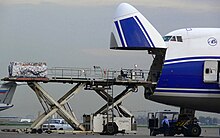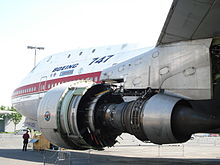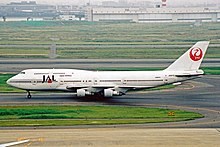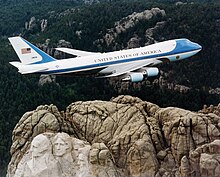Boeing 747
It has a pronounced 37.5° wing sweep, allowing a Mach 0.85 (490 kn; 900 km/h) cruise speed, and its heavy weight is supported by four main landing gear legs, each with a four-wheel bogie.The partial double-deck aircraft was designed with a raised cockpit so it could be converted to a freighter airplane by installing a front cargo door, as it was initially thought that it would eventually be superseded by supersonic transports.After several studies, the stretched 747-8 was launched on November 14, 2005, using the General Electric GEnx engine first developed for the Boeing 787 Dreamliner (the inspiration for the -8 in the name), and was first delivered in October 2011.[10] Boeing responded by designing the 747 so it could be adapted easily to carry freight and remain in production even if sales of the passenger version declined.During the ceremonial 747 contract-signing banquet in Seattle on Boeing's 50th Anniversary, Juan Trippe predicted that the 747 would be "…a great weapon for peace, competing with intercontinental missiles for mankind's destiny".[14] As launch customer,[15][16] and because of its early involvement before placing a formal order, Pan Am was able to influence the design and development of the 747 to an extent unmatched by a single airline before or since.[19][20] However, concern over evacuation routes and limited cargo-carrying capability caused this idea to be scrapped in early 1966 in favor of a wider single deck design.[15] The cockpit was therefore placed on a shortened upper deck so that a freight-loading door could be included in the nose cone; this design feature produced the 747's distinctive "hump".[26] The project was designed with a new methodology called fault tree analysis, which allowed the effects of a failure of a single part to be studied to determine its impact on other systems.The company considered locations in about 50 cities,[36] and eventually decided to build the new plant some 30 miles (50 km) north of Seattle on a site adjoining a military base at Paine Field near Everett, Washington.Boeing president William M. Allen asked Malcolm T. Stamper, then head of the company's turbine division, to oversee construction of the Everett factory and to start production of the 747.[41] The plant is the largest building by volume ever built, and has been substantially expanded several times to permit construction of other models of Boeing wide-body commercial jets.However, a particularly severe high-speed flutter problem was solved only by inserting depleted uranium counterweights as ballast in the outboard engine nacelles of the early 747s.Pilot Ralph C. Cokely undershot the airport's short runway and the 747's right, outer landing gear was torn off and two engine nacelles were damaged.[92] In January 2016, Boeing stated it was reducing 747-8 production to six per year beginning in September 2016, incurring a $569 million post-tax charge against its fourth-quarter 2015 profits.The new 747-8 freighters would replace AirBridgeCargo's current 747-400 aircraft and expand the airline's fleet and will be acquired through a mix of direct purchases and leasing over the next six years, Boeing said.[96] On July 27, 2016, in its quarterly report to the Securities and Exchange Commission, Boeing discussed the potential termination of 747 production due to insufficient demand and market for the aircraft.[101] On July 2, 2020, it was reported that Boeing planned to end 747 production in 2022 upon delivery of the remaining jets on order to UPS and the Volga-Dnepr Group due to low demand.[102] On July 29, 2020, Boeing confirmed that the final 747 would be delivered in 2022 as a result of "current market dynamics and outlook" stemming from the COVID-19 pandemic, according to CEO David Calhoun.Responding to requests from Japanese airlines for a high-capacity aircraft to serve domestic routes between major cities, Boeing developed the 747SR as a short-range version of the 747-100 with lower fuel capacity and greater payload capability.[242] The 747-600X concept featured a greater stretch to 279 feet (85 m) with seating for 548 passengers, a range of up to 7,700 nmi (14,300 km; 8,900 mi), and a gross weight of 1.2 Mlb (540 tonnes).[80] As Airbus progressed with its A3XX study, Boeing offered a 747 derivative as an alternative in 2000; a more modest proposal than the previous -500X and -600X with the 747's overall wing design and a new segment at the root, increasing the span to 229 ft (69.8 m).[246] Like its predecessor, the 747X family was unable to garner enough interest to justify production, and it was shelved along with the 767-400ERX in March 2001, when Boeing announced the Sonic Cruiser concept.[255] As the IATA forecast an increase in air freight from 4% to 5% in 2018 fueled by booming trade for time-sensitive goods, from smartphones to fresh flowers, demand for freighters is strong while passenger 747s are phased out.[275] This finding led the FAA to adopt a rule in July 2008 requiring installation of an inerting system in the center fuel tank of most large aircraft, after years of research into solutions.On July 30, 1971, Pan Am Flight 845 struck approach lighting system structures while taking off from San Francisco for Tokyo, Japan; the plane dumped fuel and landed back.Upon its retirement from service, the 747 which was number two in the production line was dismantled and shipped to Hopyeong, Namyangju, Gyeonggi-do, South Korea where it was re-assembled, repainted in a livery similar to that of Air Force One and converted into a restaurant.[307] A former British Airways 747-200B, G-BDXJ,[308] is parked at the Dunsfold Aerodrome in Surrey, England and has been used as a movie set for productions such as the 2006 James Bond film, Casino Royale.The aircraft entered the cultural lexicon as the original Jumbo Jet, a term coined by the aviation media to describe its size,[334] and was also nicknamed Queen of the Skies.[335] Test pilot David P. Davies described it as "a most impressive aeroplane with a number of exceptionally fine qualities",[336]: 249 and praised its flight control system as "truly outstanding" because of its redundancy.






























At the top: 747-100 (dorsal, cross-section, and front views). Side views, in descending order: 747SP, 747-100, 747-400, 747-8I, and 747LCF.

IberiaWide-bodyjet airlinerManufacturerBoeing Commercial AirplanesPan AmUPS AirlinesCargoluxLufthansaBoeing 747-400Boeing 747-8Boeing 747SPBoeing DreamlifterBoeing E-4Boeing VC-25Boeing YAL-1Shuttle Carrier Aircraft747 Supertankerwide-body airlinerseat costJoe SutterPratt & Whitneyhigh-bypass turbofanEverett PlantJumbo Jetfour-engined jet aircraftPratt & Whitney JT9DturbofanGeneral Electric CF6Rolls-Royce RB211travel classeswing sweepcruise speeddouble-deck aircraftfreighter airplanesupersonic transportsmaximum takeoff weightnautical miles747-400PW4000glass cockpitGeneral Electric GEnxBoeing 787 DreamlinerAir Force OnetrijetLockheed L-1011McDonnell Douglas DC-10AirbusAtlas Airaccidents and incidentsUnited States Air ForceC-141 StarlifterDouglasGeneral DynamicsLockheedMartin MariettaGeneral ElectricCurtiss-WrightC-5 GalaxyBoeing 707Douglas DC-8Juan TrippePan American AirwaysIran Airflight engineersupersonic transportintercontinental missilesturbojetsfault tree analysishydraulichigh-lift devicesKrueger flapsNorthropGrummanNorthrop GrummanFairchildLing-Temco-VoughtBoeing Everett FactorySeattlePaine FieldEverettWilliam M. AllenEverett factorymock-upprototype 747Federal Aviation Administrationfirst 747Brien WygleDutch rolllanding gearflutterdepleted uraniumnacellesEl Al Flight 1862tailplaneflight testRenton Municipal AirportRenton factoryParis Air Showairworthiness certificatePat NixonFirst LadyDulles International AirportNajeeb HalabyClipper Victorseating capacitycovert operation to airlift Ethiopian Jews to IsraelAntonov An-124Antonov An-225 Mriyacargo transportScaled Composites StratolaunchwingspanSonic Cruiser787 Dreamliner747-400ERAirbus A380maiden flightVolga-Dnepr GroupVolga-Dnepr AirlinesAirBridgeCargo AirlinesAtran AirlinesSecurities and Exchange CommissionCOVID-19 pandemichangarsVirgin OrbitLauncherOne